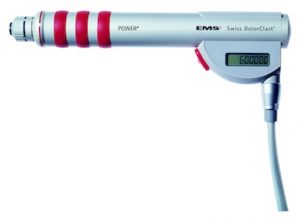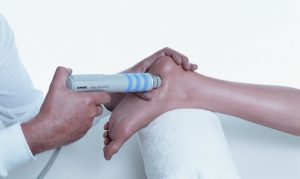Shock wave therapy is an exciting new way of treating heel pain, Achilles pain and a number of other sports injuries and long-term tendon problems.
It is great for:
- Achilles tendonitis
- Plantar fasciitis/heel pain
- Tennis elbow/golfers elbow
- Patellar tendonitis
- Quadriceps tendonitis
- Iliotibial band friction syndrome (ITBFS)
- Trochanteric hip pain
- Other tendon problems
All of these conditions are otherwise hard to treat if they don’t get better with physiotherapy and before shock wave therapy existed the next step would often be surgery.
It has a success rate of about 70-80%, so it does not work for everyone, but does help most people even when other treatments have failed. It is a great way to keep yourself away from an operation.
Shock wave can be arranged now by Emailing Charles

How does shock wave therapy work?
Shock wave therapy is a non-invasive way of restarting the natural healing process allowing your body to repair itself. The common factor in all of these conditions is the chronic inflammatory process, which is a vicious cycle of pain and damage that is often seen in association with overuse injuries. Shockwave therapy can convert this chronic inflammatory process into an acute inflammatory process much like a fresh injury, from which the body can usually heal itself.
Typically three treatments of about five minutes are required spaced over three weeks. The treatments are a bit uncomfortable, but no injections are required, and they are not nearly as painful as surgery.
How much does it cost?
Shockwave therapy is not available on the NHS in this area, however, if you are insured then it should be fully covered by your private health insurance. If not Mr Willis-Owen can see you on a self-funded basis. A new consultation costs £250 and course of three treatments costs in the region of £750 depending on your specific needs. To put this in perspective surgery typically costs about £4,000 and involves time off work and a lower success rate.
Will my insurance cover shockwave?
Most insurance does cover it, but some (typically AXA) do not, if this is the case there are ways around this which mean you may still be able to benefit from shock wave therapy. Mr Willis-Owen will discuss this with you at your consultation.
What happens during shock wave therapy treatment?
During shock wave therapy, high-intensity sound waves are sent to the tissues of the body. This leads to all sorts of beneficial effects such as new blood vessel ingrowth, reversal of chronic inflammation, stimulation of new tissue growth and breaking down calcium deposits. For you, it’s about 5 minutes of quite noisy, and a little bit uncomfortable treatment to the sore area, three weeks in a row.
Some people feel some benefit right after the session, but then it may be sore for the next day or two. The full benefit of the treatment takes some time, with most people feeling much better by 3 months. It carries on improving up to a year. If it is sore the next day please don’t take anti-inflammatories like Neurofen or Ibuprofen, as these can stop the shock wave from working well. You can take Paracetamol or Cocodaomol if you need to.

Benefits of shock wave therapy treatment
- Clinical studies report success rate above 75%
- Much cheaper than surgery
- Shock wave therapy brings new technology
- No anaesthesia required, no drugs, no injections
- Just 3 sessions of 5-minute treatments
How long does it take to work?
You are likely to feel reduced pain within minutes of starting the first treatment. You will be sore after each treatment, but it is important NOT to take anti-inflammatories. The treatment works by stimulation of a ‘pro-inflammatory state’. Most patients experience a considerable benefit by 3 months from the first treatment, but studies show improvements continue up to one year from treatment.

Are all shockwave treatments the same?
No! There are a variety of types of shockwave treatment and ways to deliver the therapy. Mr Willis-Owen uses a brand new radial shockwave therapy which has a wealth of research for sports injuries. The type of handpiece determines how much energy can be given, and the newer ceramic handpieces deliver more energy with less discomfort. Charles used to have an old “swiss dolocast” machine, but the new Stortz machine is much more comfortable and delivers more o the all-important energy for less discomfort.
We suggest that whoever gives you shockwave therapy should be experienced in treating your condition with non-operative, or surgical means so they can still help you if shockwave is not successful. Also, you should be treated by someone auditing their results, for example using the ASSERT protocol. This is a requirement of the National Institute of Clinical Excellence. See below.
Success rates
The reported success rates in scientific studies are about 75%, meaning that shockwave has a good chance of solving your problems, but not a guarantee. Mr Willis-Owen is enthusiastic about shockwave therapy but appreciates that it is not the solution for everyone. Fortunately, Mr Willis-Owen has considerable experience in the surgical treatment of these conditions, so if shockwave therapy is not effective he is ideally suited to take your treatment to the next step.
Is this approved by the NICE?
NICE have looked a shockwave therapy and found it to be safe. The scientific evidence for efficacy is equivocal and as a result, NICE has suggested that clinicians carrying out shockwave therapy should gather data on their patients in order to see how well it works. This sort of recommendation from NICE is very common indeed as it takes many years, and many patients to gather robust scientific evidence for any treatment.
For this reason, Mr Willis-Owen may ask you to enrol in the ASSERT protocol which is a simple process used to assess how effective shockwave therapy has been.
